NEW SCHOLARSHIP
Commemorating Confucius in 1966-67 | China Heritage Quarterly
Commemorating Confucius in 1966-67
The Fate of the Confucius Temple, the Kong Mansion and Kong Cemetery
孔庙、孔府、孔林
Sang Ye and Geremie R. Barmé
The recently revived and reformulated state ceremonies held in Qufu, Shandong province, to commemorate Confucius (ji Kong 祭孔) build on obsequies that date from dynastic and Republican times. As a background to our consideration of the new, Reform Era, commemoration of Confucius, we present here some preliminary research notes on the destruction of Confucius-related sites in Qufu 曲阜, Shangdong province, during the early years of the Cultural Revolution, 1966-67.
These notes are based on oral history interviews and memoirs as well as on the key Red Guard publication Persecute Kong Battle Dispatches (Tao Kong zhanbao 讨孔战报). That paper—which appeared irregularly from 10 November 1966 to 31 August 1967—was started by the Jinggang Shan Red Guard Corps of Beijing Normal University. They subsequently relocated to Qufu Normal College in Qufu county, Shandong province, where they joined forces with local Red Guards to set up an organization the name of which reflects the animus as well as the verbosity of the time. It was called the Revolutionary Rebel Liaison Station to Annihilate the Kong Family Business and Establish the Absolute Authority of Mao Zedong Thought.
Relevant articles in Persecute Kong Battle Dispatches that have been used in writing the following account include: 《捣毁孔家店,彻底闹革命,为毛泽东思想的绝对权威而战》、《告全国革命人民书》、《革命战士向伟大领袖毛主席致敬电》、《火烧孔家店——讨孔宣言》、《井冈山战士满怀革命豪情在天安门前宣誓》、《历代农民对孔孟之道的讨伐》、《彻底捣毁孔家店,树立毛泽东思想绝对权威——孔府罪恶史展览馆介绍》、《孔孟之道、武训精神与刘氏修养》、《彻底打倒孔家店,树立毛泽东思想的绝对权威的十点建议》、《捣毁孔家店,把曲阜师范学院变成了红色的海洋》、《天翻地覆慨而慷》. Illustrations 1-6 are also taken from that publication.
Annihilating the Kong Family Business
捣毁孔家店
The Business of Revolution
On 7 November 1966, the Jinggang Shan Red Guard Corps of Beijing Normal University (北京师范大学毛泽东思想红卫兵井冈山战斗团) gathered in Tiananmen Square en masse and swore an oath to 'Annihilate the Kong Family Business' (daohui Kongjiadian 捣毁孔家店).
On 10 November, under the leadership of Tan Houlan 谭厚兰 , one of the original rebels at Peking University, over 200 Red Guards representatives including members of the same Jinggang Shan Red Guard Corps went to Qufu 曲阜 in Shandong province, the home of the Kong family, of which Confucius was the most famous member, the Kong Temple and the Kong Family Cemetery. Along with students from the Qufu Normal College they established a 'Revolutionary Rebel Liaison Station to Annihilate the Kong Family Business' 彻底捣毁孔家店革命造反联络站.
On 12 November, the Revolutionary Rebel Liaison Station requested guidance from Qi Benyu 戚本禹 and Chen Boda 陈伯达, both members of the Cultural Revolution Leadership Group in Beijing. Chen issued a directive in which he said that they could 'hold a mass rally and dig up Confucius' ('可以开大会,孔坟可以挖掉') grave. Accordingly, they made preparations.
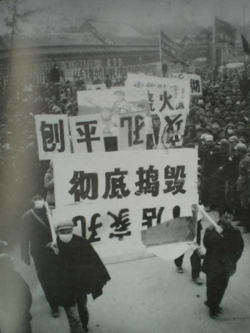
Fig. 1 参加彻底捣毁孔家店大会的红卫兵进入会场。
Formal march in to the Mass Rally for the Thorough Smashing of the Kong Family Business
The Denunciation
On 15 November, the Revolutionary Rebel Liaison Station to Annihilate the Kong Family Business organized a mass rally outside the Kong Mansion 孔府 in the centre of Qufu and destroyed the National Cultural Relics Stelae previously erected there on orders of the State Council at the Confucius Temple, the Kong Mansion, the Kong Forest (the Kong family cemetery) and the Ancient City of the State of Lu. They also sent a formal letter of protest to the State Council for its having issued protection orders over these various 'reactionary' sites.[Fig. 1]
On 25 November, the Party Committee of East Wind Commune (now renamed Shuyuan Township 书院镇) received a telephone instruction from the Qufu County Party Committee ordering them to organize a team of 300 local workers into a 'Poor-and-Lower-Middle Peasant Grave Digging Team'. Their task was to assist the Red Guard Shock Brigade in smashing stelae and digging up the tomb of Confucius. The County Party Committee would give the workers 50 cents per head per day for a job that was estimated would take two to three working days. Kong Qingju 孔庆举, the Commune Party Secretary, put Zhu Hongjiang 褚洪江, a cadre in the local civil affairs department, in charge of requisitioning the required manpower. At the same time an armed force of 20 militia members was organized to patrol the site.
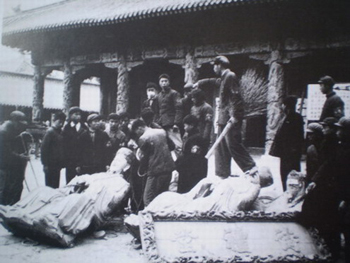
Fig. 2 孔子塑像被拉倒,正在被拖出准备游街。
The statue of Confucius having been pulled down is prepared for parading through the streets.
On 28 November, an Annihilate the Kong Family Business Rally was held outside the Confucius Temple 孔庙 and, following speeches by Tan Houlan and other Red Guard representatives, the County Party Secretary, Li Xiu 李秀, spoke in resolute support. Zhou Yutong 周予同, a specialists in Chinese classics, the philosopher Yan Beiming 严北溟 and the historian Gao Zanfen 高赞非, all men who had participated in the last ceremony to commemorate Confucius held in Qufu in 1962 were brought in from Shanghai and other locales under guard to be 'struggled', that is denounced in ritualistic fashion, along with Confucius himself. Following the conclusion of the formal meeting and denunciations, the statue of Confucius in the temple was toppled and then carried through the streets of the town to be vilified.[Fig. 2] The scholars in attendance were forced into the entourage and denounced for being 'Filial Sons and Virtuous Grandsons Paying Last Respects to Kong the Second Son' (孝子贤孙们为孔老二送丧).
The Dig
On the morning of 29 November, Zhu Hongjiang led his team of gravediggers who were armed with picks and shovels to the Confucius Cemetery (Kong Lin), a large enclosed area containing graves of Kong clan members. By this time Red Guards were already busy pulling down the stone stelae and commemorative arches positioned along the spirit way leading to the main tomb. The gravediggers came across one group of Red Guards who had clambered onto an archway and were busy defacing the characters on it that read 'Eternal Spring' (Wangu chang chun 万古长春).[Fig. 3]
The cadres of the East Wind Commune told the amassed Red Guards that there were 70 graves in the Confucius Cemetery belonging to Confucius himself and his direct descendants, as well as another 2,000 graves of Kong clan members. They warned that it would take much more than a few days to dig up all these graves. After some deliberation it was decided that they would dig up the 'First Kongs and the Last Kongs' (shang san Kong he xia san Kong 上三孔和下三孔), that is, Confucius as well as sons and grandsons, and the last three generations of Confucius' lineage, that is Kong Lingyi 孔令贻, his father and grandfather.
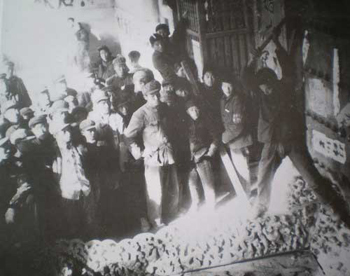
Fig. 3 大成殿匾被摘下砸烂。
The plaque at the Dacheng Dian main hall at the Confucius Temple, having been taken down, is smashed.
Confucius' descendants were given the rank of marquis from the Han dynasty, and promoted to duke from the Tang. In 1055, a Song emperor bestowed the title of 'Duke of Continued Saintliness' Yansheng gong 延圣公 on the 46th-generation descendant of Confucius. Kong Lingyi had inherited that title. His son, Kong Decheng 孔德成, was the last member of the clan to hold the title; it was bestowed on him by Xu Shichang, President of the Republic of China, in 1935. At the time of the Red Guard action, Kong Decheng was living in Taiwan.
The Red Guards and the local Party authorities declared that the proposed plan meant that symbolically they would have destroyed the Kong Family Business 'from beginning to end'. Thereupon, 200 workers were dispatched with the Red Guards to dig up the 'First Kongs' and another 100 went with Zhu Hongjiang to dig up the 'Last Kongs'.[Fig. 4]
Reporting to Chairman Mao
That same day (29 November 1966) the mass rally composed and sent a telegram to Chairman Mao, the text of which read:
Dearest Chairman Mao,
One hundred thousand members of the revolutionary masses would like to report a thrilling development to you: we have rebelled! We have rebelled! We have dragged out the clay statue of Kong the Second Son (Kong lao'er 孔老二); we have torn down the plaque extolling the 'teacher of ten-thousand generations'; we have leveled Confucius' grave; we have smashed the stelae extolling the virtues of the feudal emperors and kings, and we have obliterated the statues in the Confucius Temple!
敬爱的毛主席:十万革命群众向您汇报一个激动人心的消息,我们造反了!我们造反了!孔老二的泥胎被我们拉了出来,万世师表的大匾被我们摘了下来,孔老二的坟墓被我们铲平了,封建帝王歌功颂德的碑被我们砸碎了,孔庙中的泥胎偶像被我们捣毁了!
The authors of this telegram were exaggerating when they claimed that: '100,000 members of the revolutionary masses' had participated in this vandalism. In reality, some 20,000 people attended the 28 November mass rally. If one includes all of the people who watched on as the tombs were dug up over the following two-day period one could claim that some 100,000 people had been involved. As for having 'leveled Confucius' grave', the reality was that on the first day the grave was flattened, on the second day a three-metre deep trench was dug, but by the third day the rebels had run out of patience so they used dynamite to blow up the site. The grave was effectively obliterated.
The Loot
Eyewitnesses and participants claim that the majority of onlookers of the maelstrom were less concerned about the revolutionary action per se than seeing for themselves what treasures might be unearthed from these prestigious gravesites. They were particularly interested in the exhumations carried out at the 'Last Kongs' graves. Zhu Hongjiang says, 'I led 100 people to the Qing-era graves on the eastern side of the Confucius Cemetery. I divided them into two teams of 50: one dug up Kong Lingyi and the other dug up [his father] Kong Xiangke 孔祥珂. When we unearthed the stone sarcophagi everyone rushed over to see. We decided to leave the next stage to the following day.'
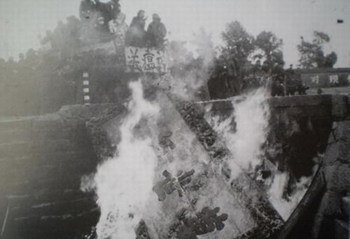
Fig. 4 康熙御笔万世师表匾被拉到孔林火烧毁。
The plaque bearing the Qing Kangxi emperor’s inscription, ‘Teacher of Ten-thousand Generations’, is taken to the Confucius Graveyard to be burnt.
On November 30, in keeping with instructions from the Qufu County Party Committee, members of the local Cultural Relics Committee and the People's Bank gathered at the site of the exhumed 'Last Kongs'. They were on the scene to evaluate the worth of the relics presumed to be in the unearthed coffins. The large stone coffins were broken open by being lifted and dropped from a makeshift winch. Medical personal, armed militia and Red Guard representatives oversaw the process whereby corpses were pulled out of the coffins (which included the Kong patriarchs their wives and concubines) and the confiscation of gold, jewelry and other precious objects that had been interred with the dead. The majority of onlookers were descendants of the Kong family and there were gasps of delight and shouts of excitement as each precious object was recovered from the graves. The discovery of such plunder elicited such local excitement and expectation that, given the general rapacious atmosphere, for the following three months there was something of a grave-robbing mania in the area.
The Defilement
On midday November 30, once the corpses had been removed from the coffins, onlookers took the corpses of two men and one woman to the grass nearby and stripped the other female corpses and hung them from a tree. Zhu Hongjiang recalls that, 'The bodies were on public display for five or six days after which they were thrown into a ditch in the south-east corner of the Kong Cemetery and incinerated. People felt that so many people were coming to look at the naked corpses—which were of both men and women—that it was best to burn them.'
One onlooker by the name of Kong Fanyun 孔繁云 recalls, 'I've forgotten nearly all the details though I do have a strong memory of two odors: one was that of disinfectant, the kind you get in a hospital. It was as though they were going to operate in the open air. Then there was the stench of the corpses. It made you want to vomit. As for the atmosphere, it was just like a temple fair, the were such jostling crowds. Some were outsiders [with non-local surnames] but also members of our extended family [surnamed Kong]. Some even prodded the corpses with sticks. Forget all that stuff about ours being a noble family honoured by ages. No one bothered covering up the nakedness of our ancestral grandmothers! (什么千秋万世帝王家啊,甭说收尸,连悄悄去给光腚的祖奶奶遮块布的也没有), let alone bother taking them away'.
Victory Celebration
A quotation from the issue of Persecute Kong Battle Dispatches dated 31 August 1967 offers an 'official' Red Guard summation of the event. This report was composed by the Revolutionary Rebel Liaison Station to Annihilate the Kong Family Business and is typical of the diction of the time:

Fig. 5 成化碑被拉倒。
The Chenghua Stele is pulled down.
1966年11月,十万革命大军涌进孔庙,踏上孔老二的供桌,在圣人头上动手动脚,为所欲为。他们开膛剖腹,掏出了孔老二的五脏,把它拉下宝座,踏在脚下。历代狗皇帝肉麻地吹捧孔老二的什么至圣先师、万世师表的大匾额也被拉将下来,一火焚之。滚滚的洪流杀进了孔林,砸碎了石碑,扒开了孔坟。让那些衣冠楚楚的圣人之徒跪在孔老二墓前啃地皮吧!大地主、恶霸孔老二七十六代孙孔令贻的狗坟也被扒开了,贫下中农开棺戳尸,把死狗烧成了灰烬。他们气愤地说"狗东西,你也有今天"!群众这种举动好极了!这是对孔老二及其吹捧者刘少奇之流的愤怒控诉。
The Statistics
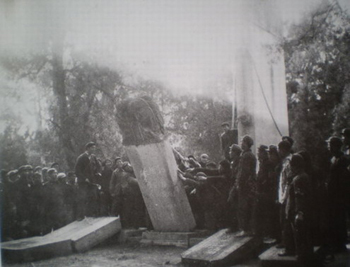
Fig. 6 大成至圣碑被拉倒,随后砸碎。
The ‘Ultimate Sage Stele’ at the Dacheng Hall of the Confucius Temple is pulled down and smashed.
The Revolutionary Rebel Liaison Station to Annihilate the Kong Family Business was stationed in Qufu for twenty-nine days. According to statistics published after the Cultural Revolution, during their stay the group was involved in the burning or pulping of some 100,000 volumes (either sets or fascicles) of classical texts of which 1,700 were rare items (shanben 善本). Some 6,618 cultural artefacts were destroyed or damaged, of which seventy were Grade One Cultural Artefacts. One thousand stelae were smashed. The interior of the Confucius Temple was destroyed and the Kong Mansion and Kong Cemetery were severely damaged. Some 5,000 ancient pines were felled and over 2,000 graves were dug up.[Fig. 6]

Fig. 7 Commemorating Confucius on 4 April 2009.
In reality, some of these losses were unconnected to so-called 'revolutionary actions' (geming xingdong 革命行动), rather they were the result of a mass grave-digging frenzy authored by locals looking for treasure. In November 1966, only the six ancestral Kong family graves were dug up as part of the formal movement to 'smash the Kong Family Business', the other 2,000 graves were despoiled during the spring of 1967. As Kong Fanyun recalls:
You could start digging anywhere. The booty belonged to whoever dug it up. They say one guy dug up a tractor [that is, he was able to buy a tractor by selling what he had found as a result of grave-robbing]. Later the Production Brigade of the local People's Commune expressed their disapproval. They felt it was unfair that outsiders and non-Kong families (wairen waixing 外人外姓) were able to share the loot just because they dug too. So, they divided the Kong Cemetery into zones allocated to specific teams. Later on, the county government issued an order banning all digging, but by then it was too late. During the grave-digging frenzy (pafenchao 扒坟潮) all the graves in the Kong Cemetery and vicinity were dug up and plundered for anything of value.
And Ge Hongjiang remarks:
I was in charge of the digging, just as later on I was in charge of the people who enforced the ban. By then not one grave in the Kong Cemetery survived intact.
With the passing of the grave-robbing frenzy the Qufu Branch of the People's Bank of China was authorised to buy the gold found in the tombs by locals and RMB101,000 was spent in the process. Following the Cultural Revolution, as the Confucius Temple and Kong Family Mansion were being restored it was deemed necessary to retrieve objects taken by locals for the new displays. The Qufu County Cultural Relics Management Committee spent RMB300,000 to buy back 'funerary objects dispersed among the masses' (sanluo minjian suizangpin 散落民间随葬品) as a result of the revolutionary passion.
Today
The latest commemoration of Confucius was held in Qufu on 4 April 2009.[Fig. 7] For a report in English, see the People's Daily account at: http://english.peopledaily.com.cn/90001/90783/91300/6630238.html.